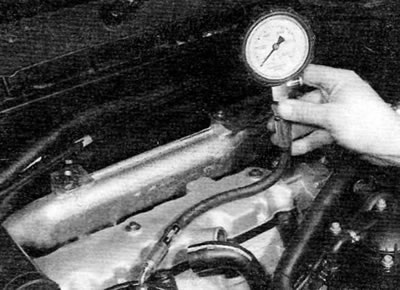Note. To perform this test, you will need a compression tester designed specifically for diesel engines.
1. If there is a drop in power or if there is a misfire that cannot be «write off» for a fuel system malfunction, a compression test can provide information about the condition of the engine. If such a check is performed regularly, you can know about the occurrence of a malfunction before any other signs of it appear.
2. You should use a compression tester designed specifically for diesel engines, as the compression pressure in them is much higher. The compression gauge is mounted on an adapter that is screwed into the hole for the glow plug or nozzle. These models require an adapter screwed into the injector holes. This is due to the limited access to the holes for glow plugs (pic. 2.2). You should not specifically buy a compression gauge for one-time use. Better borrow it from someone else or have this test done at a service station.

Pic. 2.2. Performing a Compression Test
3. Unless otherwise supplied with the compression tester, follow these instructions:
- A) The battery must be well charged, the air filter element must be clean, and the engine must be at normal operating temperature.
- b) Remove all injectors or glow plugs before starting the test. If you are removing the injectors, also remove the flame deflectors, otherwise they may fly out.
- V) Disconnect the engine immobilizer electrical connector on the back of the injection pump.
4. It is not necessary to hold the accelerator pedal during the test, since the air intake of the diesel engine is not throttled.
5. Compression pressure readings are not as important as compression ratio between cylinders. Values are given in «Specifications».
6. The cause of insufficient compression on a diesel engine is more difficult to establish than on a gasoline one. Filling oil into cylinders («wet» examination) cannot give a definitive opinion as there is a risk that the oil will remain in the swirl chamber or in the recess in the piston head and not reach the piston rings. However, when diagnosing, you can use the following recommendations.
7. Pressure values in all cylinders should be very close. A difference greater than prescribed between any pair of cylinders indicates a malfunction. Know that on a serviceable engine, compression should build up quickly. Low compression in the first cycle and then a slow increase in pressure in subsequent cycles is a sign of worn piston rings. Low pressure in the first cycle, which does not increase in subsequent cycles, indicates a leak in the valves or a burnt cylinder head gasket (Cracks in the head could also be the cause). Low compression can also be caused by deposits on the inside of the valve heads.
8. Low compression in two adjacent cylinders is almost certainly the result of a burnt-out or breakdown of the cylinder head gasket between them. This can confirm the presence of coolant in the engine oil.
9. If the compression reading is unusually high, it is possible that the surfaces of the cylinder head, valves and pistons are coated with carbon deposits. If this is the case, you should remove the cylinder head and remove carbon deposits (see chapter 2E).
Check for leaks
10. The leak test is to measure the rate at which the compressed air supplied to the cylinder escapes. This is an alternative to a compression test, and in many ways it's even better, as the escaping air makes it easy to see where pressure is being lost (piston rings, valves or cylinder head gasket).
11. It is unlikely that you have the equipment required to perform this test. If engine compression is insufficient, have a leak test carried out by a workshop equipped with this equipment.
